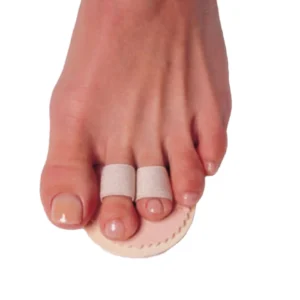
The Budin toe splint is a specialized orthopedic device designed to help correct and alleviate discomfort associated with toe deformities, particularly hammer toes, claw toes, and mallet toes. These conditions involve abnormal bending of the joints in one or more of the toes, which can cause pain, irritation, and even difficulty walking. The splint is named after Dr Harry A Budin who first wrote about it in a book in 1941
Purpose:
The Budin splint is meant to support the toe(s) in a straightened position, which helps alleviate pressure and pain. By realigning the toe, it reduces strain on the joints, muscles, and tendons, giving them a chance to heal or prevent further damage.
Design:
Most Budin splints are made with soft, flexible materials such as foam or silicone. They often consist of a cushioned loop that fits around the toe, which is connected to a flat pad or bar that rests beneath the metatarsal area (the ball of the foot). This design keeps the toes properly aligned and offloads pressure from the affected joints.
Comfort:
They are typically lightweight and low-profile, allowing users to wear them comfortably inside most shoes. This makes them convenient for day-to-day use, particularly for those who need to be on their feet for long periods.
Types:
Single-toe splints: Used to correct the deformity in a single toe.
Multi-toe splints: Used to correct multiple toes at once. These may have more loops and a larger base to support more than one affected toe.
Conditions it addresses:
Hammer Toe: A condition where the middle joint of a toe bends downward, creating a hammer-like appearance.
Claw Toe: When the toe bends upward at the base and downward at the middle and end joints.
Mallet Toe: A deformity where only the joint closest to the tip of the toe is bent downward.
Usage:
People who use Budin splints often do so to relieve pain caused by friction or pressure on the affected toes when walking or standing.
It can also prevent further deformities in toes by keeping them aligned properly.
Budin toe splints are typically used in conservative treatment strategies and may be combined with other forms of therapy, such as physical therapy, stretching exercises, or custom orthotics.
Benefits:
Relieves Pressure: Helps reduce the rubbing and irritation that leads to corns, calluses, and general discomfort.
Non-surgical Option: Offers a conservative approach to managing toe deformities without resorting to surgery.
Easy to Wear: Can be used with most types of footwear, so it’s practical for daily activities.
Limitations:
Not a Cure: While a Budin splint can relieve symptoms, it doesn’t correct the underlying structural deformity permanently. In severe cases, surgery may still be required.
Limited Use for Advanced Deformities: In cases where the deformity is rigid and severe, the splint may not be as effective.